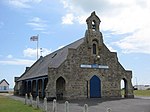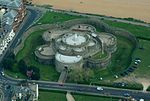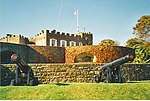St Saviour's, Walmer
1848 establishments in England19th-century Church of England church buildingsChurch of England church buildings in KentChurches completed in 1848English church stubs ... and 2 more
Religious organizations established in 1848Use British English from March 2021

St Saviour's is a church on the seafront of Walmer, Kent, United Kingdom.
Excerpt from the Wikipedia article St Saviour's, Walmer (License: CC BY-SA 3.0, Authors, Images).St Saviour's, Walmer
York Road,
Geographical coordinates (GPS) Address External links Nearby Places Show on map
Geographical coordinates (GPS)
| Latitude | Longitude |
|---|---|
| N 51.213611111111 ° | E 1.4022222222222 ° |
Address
St Saviour's Church
York Road
CT14 7EB , Lower Walmer
England, United Kingdom
Open on Google Maps








